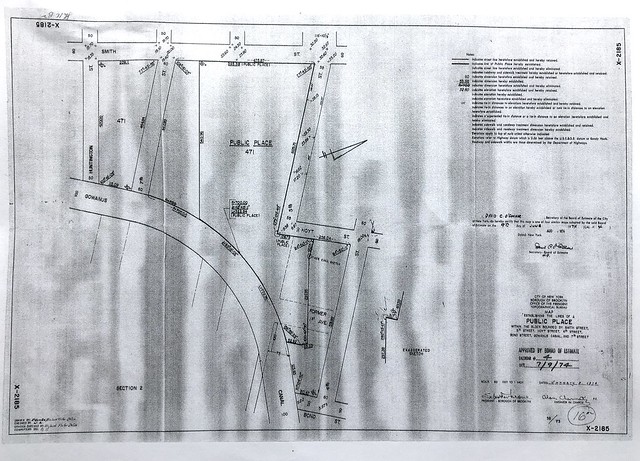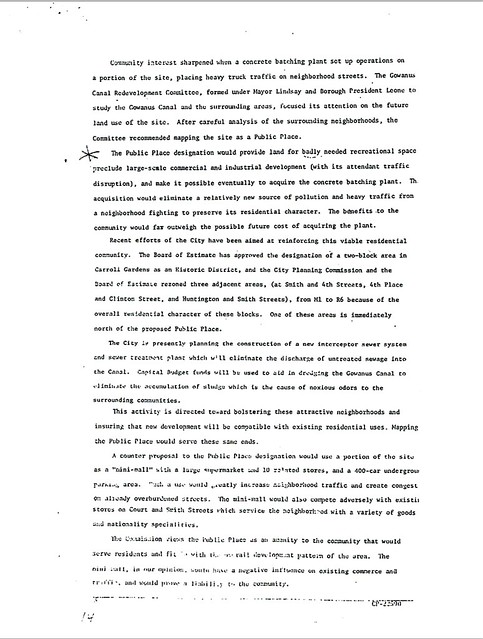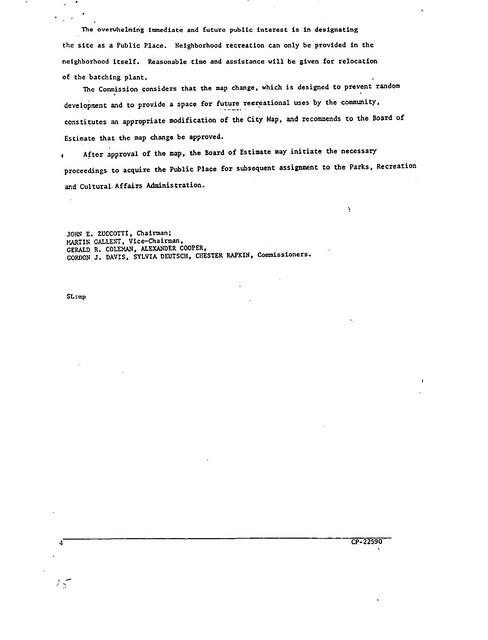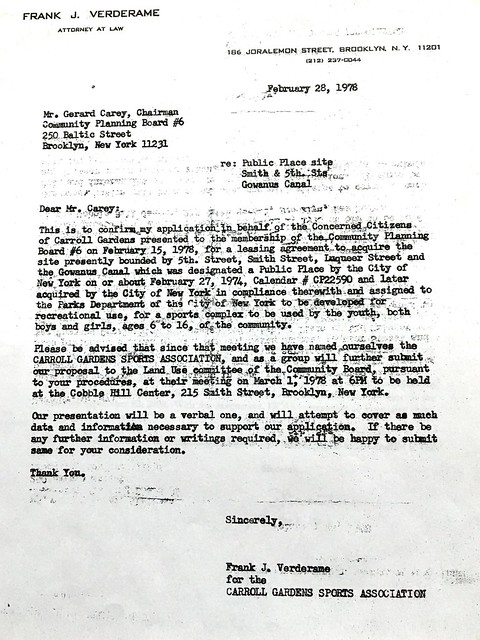Councilman Brad Lander
Public Place site at Smith and 5th Street
Looking At Public Place from Hoyt Street
2008 Hudson Company rendering for Gowanus Green
One of the slides from the Gowanus Neighborhood Planning Study mentioning the need to remove the Public Place designation in order to build on the 5.8 acre site.


In "Brad Lander's Brownfield Of Dreams Part 1", I wrote at length about our council member's desire to see housing and a school built on Public Place, the most polluted site along the Gowanus Canal.
Lander has been pushing for Gowanus Green, the name of this new development for more than ten years. A team of developers has been chosen and the plan for Public Place calls for 1000 units of 100% affordable housing in 30 story buildings . It also calls for a public school, community facilities and open space.
Back in 2008, Gowanus Green was about to move forward. All that was needed was to rezone the land from industrial to mixed-use through the Uniform Land Use Process (ULURP)
The very first scoping hearing took place on December 17, 2008.
And then the Gowanus Canal was declared an EPA Superfund site and the ULURP went no further.
What most local residents did not know at the time because it was not advertised nor mentioned at the hearing, was that Public Place had a very special designation.
For decades, Carroll Gardeners have referred to the empty parcel (Block 471, Lots 1 and 100) as "Public Place' since it was their understanding that it was given back to the community as park land.
Indeed, the use of the site is restricted to this very day by a 1974 Board of Estimate ruling that severely limits its uses allowed as-of-right.
After a thorough community review process shortly after the City acquired the site, the City of New York's Planning Commission and Board of Estimate set aside the 5.8 acres "for public recreational use" on the City Map on February 27, 1974, (Calendar CP 22590).
A supportive document from April 3, 1974 states:
"City Councilman Thomas J. Cuite and representatives of State Senator Carol Bellamy and Assemblyman Michael Pesce recommended that Public Place designation be adopted in view of the overwhelming demand throughout the community for available open space which should be set aside for public use. Also stressed was the necessity for such space in order to preserve the vitality and stability of the residential neighborhood."
Appropriately, the land was first assigned to the NYC Parks Department, but later moved to the Department of Citywide Administrative Services (DCAS), before being transferred in 2008 to the NYC Department of Housing Preservation and Development(HPD). Shortly afterwards, the City took steps to spot-rezone the site for the Gowanus Green development and issued a Draft Scope of Work for an Environmental Impact Study in November 2008.
The 2008 Draft Scope of Work specifically mentions several discretionary actions that would have to be taken as part of a re-zoning, including a "map amendments to the city map to: (i) remove the Public Place designation on Lots 1 and 100" (PAGE 5).
Now that the City has included Public Place in its overall rezoning of Gowanus, many in the community are concerned that the move is a way to rezone Public Place without addressing its specific restrictions. Our local Electeds, Community Board or NYC DCP have not been forthcoming with information or acknowledgement that there may be a 'deed restriction'. There is a "mention of proposed city map changes" in the Gowanus Neighborhood Planning Study, but it is never talked about openly.
They are probably hoping that most in the neighborhood have forgotten that the land was given back to the community for recreational use.
In the past, there have been attempts to turn Public Place into parkland. Former Carroll Gardens Assemblyman, neighborhood activist and Second Place resident Frank Verderame' dream was to turn it into ballfields for local kids. He reminded the City of its own recommendation to set it aside for public recreation when the Gowanus Green development was first discussed. Unfortunately, he passed away in 2008, his dream for Public Place never realized.
This has always been an environmental justice issue. For generations, Carroll Gardens and Gowanus residents have been exposed to all sorts of environmental dangers from former MGP sites as well as from pollutants that were discharged into our canal and seeped deeply into the ground.
In 1974, Community Board 6 and our elected officials supported the special designation of Public Place. They rejected building on the land. The Planning Commission concluded that "the overwhelming and future public interest is in designation of the site as a Public Place."
Brad Lander, our councilman, has not been honest with us. His own dream is to bring an estimated 22,000 new residents to the Gowanus Corridor.
He touts that as part of the rezoning, the neighborhood will gain 'open space' on Public Place if 1000 apartments are built as part of the Gowanus Green development.
If Brad Lander wants to take Public Place away from the community, to give it to developers, we need to demand a stand-alone process, apart from the overall Gowanus rezoning, one that will allow us to consider a 'no build option.'
This Monday, December 2, the NYC Department of City Planning and NYC Housing, Preservation, and Development will be presenting an update on the Public Place / Gowanus Green site to Community Board 6 at PS 32.
PLEASE ATTEND AND TELL BRAD We Know That Public Place Is OURS!
Public Place/Gowanus Green Presentation to CB6
Monday, December 2, 6:30 PM
P.S. 32
317 Hoyt Street
Below is a video taken in 2010, in which Brad Lander, when pressed by a Gowanus resident, acknowledged that Public Place 'had an ususual designation.




















.JPG)

14 comments:
I'm no fan of Brad Lander's but 100% affordable housing? If that's is actually possible, it would be a miracle. And I say that as a property owner in this neighborhood.
did you read part 1? There will be liquid coal tar under Public Place for all eternity. The Brownfield clean-up only 'contains' the pollution, but the capping can fail, Hardly a place where we should be putting people in luxury OR affordable housing.
100% affordable housing on a parcel overlying coal tar? Somewhat in conflict with Lander's "equity" agenda, no?
Telling me you want to put 100% affordable housing on Public Place site is telling me that people who can't afford to live anywhere better will have to just put up with the environmental dangers of living on toxic land that will NEVER be completely clean. That's why they can only build rentals there. No one who can afford to live in a cleaner place would want to live on Public Place site. Calling it Gowanus Green is about as ironic as you can get. Because it couldn't be father from the truth. This site will forever require oversight to monitor. Building dense housing there is criminal, and a sad reflection of our society.
As for the "affordable housing" angle.
“Affordable housing” is a catch phrase meant to sound benign and altruistic. When proposing building tall and dense, out of context, and taking land away from the community, it makes the medicine go down a little easier to the community when it’s touted as being necessary to create “affordable housing.”
But what exactly does “affordable housing” mean? If you unpack just those two words, it sees simple enough. It is putting a roof over people’s heads that they have enough money to pay for. Who can argue against that?
But people, please, the devil is in the detail – and it’s not as simple as it would appear.
A quick Google search brings up a quick example of how “affordable housing” did not deliver the benign 2-word promise. Here’s the website, 2nd article down:
https://www.dnainfo.com/new-york/20160111/gowanus/more-than-56k-people-applied-for-86-affordable-apartments-on-gowanus-canal
93,000 people applied for 300 units In Prospect Heights. You would have thought all those units would have been filled lickety-split. But no, a year later apartments that were designated as “affordable housing” ended up being listed on Easy Street (a rental website). Why? According to the DNA article, the building’s developers “said all of the empty units are reserved for a specific group of people: those earning the most money.” Specifically,
“ households that earn between 135 percent and 165 percent of the area median income, which works out to between $74,606 and $173,415 per year, depending on family size.”
There are more examples, but for the sake of brevity, you get the idea.
When you tell me you’re doing something to create “affordable housing,” what I really hear is that you’re calling me a sucker.
A public parking garage is needed, and could generate both income for Bard’s developer friends and many blue-collar jobs — without unduly endangering the health of people desperate for rental housing. But a facility involving more sewage being dumped into the Gowanus Canal contradicts everything the Superfund clean-up is supposedly trying to achieve.
While I wouldn't want to live on a brownsite myself, when I read these posts I always wonder what the actual goal of this fight is -- to keep these big tracts of collapsing warehouses and deserted industrial sites exactly as they are? To never build anything new in between Carroll Gardens and Park Slope?
As a reasonably community-minded person who keeps an eye on this situation but isn't embroiled in it and owns a home two blocks from the Canal, that sounds bananas to me -- these sites are uninhabited eyesores sandwiched between two desirable neighborhoods, and they're going to be redeveloped, no matter who's in charge. Much better to fight for things that will help us WHEN the redevelopment happens -- upgrading the sewer, getting the environmental markers checked/upgraded regularly, preserving enough historic structures -- than fight the entire concept of redevelopment itself, no?
"While I wouldn't want to live on a brownsite myself"...so who should live there? Are we really saying it is ok for those who need affordable housing to live there?
"was given to the community in the 1970's as parkland" is a false statement. Read the resolution CP-22590 where on March 13, 1974, the community support was for recreational public use but the resolution . A Public Place zoning map designation limits uses to those that benefit the community. The map change blocked the supermarket & mini-mall proposal. After the owner gave up the property to the City, the land was leased for 45 years to a concrete user under the argument that the community benefited from local concrete production. The new public purpose is affordable housing.
Over the decades, there have been many visions for this Public Place, including a sports complex, parking and affordable senior housing.
The last community visioning session was in 2007. Those sessions happened before we were told the extend of the pollution on the land. They also happened before the community was fully informed that the entire Gowanus Corridor was slated to be rezoned.
I would expect Brad Lander to push for a comprehensive clean-up of the site first. He ,nor anyone else, can tell us with certainty that housing and a school are actually viable here. Instead, he is asking us to pick out the color of the brick for the development.
Time to have another community session, a stand alone one, separate from the massive rezoning of the entire Gowanus Canal. Let's put everything on the table and have a REAL discussion on what makes sense for the community.
"Are we really saying it is ok for those who need affordable housing to live there?"
Millions of people across the economic spectrum in this city live on horrifically polluted land -- the very fact that these buildings are being built with that knowledge and testing in hand will most likely make those residents safer than a hell of a lot of people currently living in Gowanus, Greenpoint, Williamsburg, Red Hook, LIC, etc. I am sure this is the logic the people who buy million-plus condos in these neighborhoods are following, and while I would not personally make that choice, I also have no idea what's under my own 100-year-old building, so who knows what I'm living with now?
Do you remember all those articles a few years back about how people who grow vegetables and raise chickens in their backyards and community gardens have no idea how full of lead the city's soil is, just from soaking up a century's worth of leaded-gas car exhaust? Do you wear gloves and a mask whenever you pull a weed in your back yard? I don't.
It just seems like the real objection is for *anything* to happen to these sites, and *any* more people to move to this area, which is unrealistic given the location and the amount of unused space... and isn't affordable housing better than more million-dollar condos?
It certainly could be that the coal tar plume from Public Place extends past the Public Place site, despite all of National Grids sampling in and around the site. I would not be surprised.
I learned from EPA that coal tar attaches to native soil in a wicking action, so can move anywhere. So your point is well taken, but please don't fall back into this very tiresome suggestion that any reasonable request for community involvement is based on NIMBYism.
I spent a significant amount of time trying to understand the issues, searching for documentation and information, so that I may transmit them to my neighbors since our elected officials would prefer us to stay ignorant.
I am proposing that we discuss Public Place with ALL the facts at tonight's meeting.
Hope you will be there and please say hi. I love meeting my neighbors.
One of the reasons that the Gowanus rezoning is entirely rentals as opposed to condos like the scrapped Toll Brothers project is that banks won’t lend on property adjacent to a superfund site. This should give people pause.
Ginger Vitis brings up several good points. how do we really know what we’re dealing with and how do we get transparency and credible facts and histories, even when it comes to our own backyards?
it is something i think about often - how can we get information that is trustworthy and where do we go?
when it comes to researching the history of ground pollution in carroll gardens and how it might apply to any particular lot in the neighborhood, whether it’s a proposed development or it’s a backyard that hasn’t been renovated in decades, where are the sources in this city who can provide that kind of data but also operate independently from organizations (whether public or private) who might otherwise wield undue influence over their findings?
and how do we know whether or not the information is trustworthy? and that’s not just because of possible malfeasance but also because research and data needs to be updated and maintained; while over the years, new approaches to how we gather data and where we look to find it result in updates of previous conclusions...
hope the meeting last night went well. look forward to hearing more about it.
At the EPA Community Advisory Group, we had asked for a comprehensive health study of the Gowanus Corridor. The Department of Health basically told us that we are surrounded by health risks from the toxins in the ground, fumes from the BQE and every day traffic on our streets. It would basically be impossible to do a cancer study and determine with accuracy which of these pollutants would trigger illness since they surround us.
As far as the coal tar, we know that it migrated from Thomas Greene park from the former MGP site at Nevins Street across the street, down one block to the Gowanus and under some surrounding buildings.
I never believed that the coal tar plume on Public Place stopped at the sidewalk in front of the property.
It is all very very scary.
Post a Comment